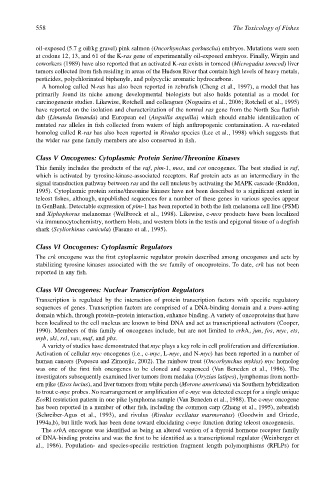Page 578 - The Toxicology of Fishes
P. 578
558 The Toxicology of Fishes
oil-exposed (5.7 g oil/kg gravel) pink salmon (Oncorhynchus gorbuscha) embryos. Mutations were seen
at codons 12, 13, and 61 of the K-ras gene of experimentally oil-exposed embryos. Finally, Wirgin and
coworkers (1989) have also reported that an activated K-ras exists in tomcod (Microgadus tomcod) liver
tumors collected from fish residing in areas of the Hudson River that contain high levels of heavy metals,
pesticides, polychlorinated biphenyls, and polycyclic aromatic hydrocarbons.
A homolog called N-ras has also been reported in zebrafish (Cheng et al., 1997), a model that has
primarily found its niche among developmental biologists but also holds potential as a model for
carcinogenesis studies. Likewise, Rotchell and colleagues (Nogueira et al., 2006; Rotchell et al., 1995)
have reported on the isolation and characterization of the normal ras gene from the North Sea flatfish
dab (Limanda limanda) and European eel (Anguilla anguilla) which should enable identification of
mutated ras alleles in fish collected from waters of high anthropogenic contamination. A ras-related
homolog called R-ras has also been reported in Rivulus species (Lee et al., 1998) which suggests that
the wider ras gene family members are also conserved in fish.
Class V Oncogenes: Cytoplasmic Protein Serine/Threonine Kinases
This family includes the products of the raf, pim-1, mos, and cot oncogenes. The best studied is raf,
which is activated by tyrosine-kinase-associated receptors. Raf protein acts as an intermediary in the
signal transduction pathway between ras and the cell nucleus by activating the MAPK cascade (Ruddon,
1995). Cytoplasmic protein serine/threonine kinases have not been described to a significant extent in
teleost fishes, although, unpublished sequences for a number of these genes in various species appear
in GenBank. Detectable expression of pim-1 has been reported in both the fish melanoma cell line (PSM)
and Xiphophorus melanomas (Wellbrock et al., 1998). Likewise, c-mos products have been localized
via immunocytochemistry, northern blots, and western blots in the testis and epigonal tissue of a dogfish
shark (Scyliorhinus canicula) (Fasano et al., 1995).
Class VI Oncogenes: Cytoplasmic Regulators
The crk oncogene was the first cytoplasmic regulator protein described among oncogenes and acts by
stabilizing tyrosine kinases associated with the src family of oncoproteins. To date, crk has not been
reported in any fish.
Class VII Oncogenes: Nuclear Transcription Regulators
Transcription is regulated by the interaction of protein transcription factors with specific regulatory
sequences of genes. Transcription factors are comprised of a DNA-binding domain and a trans-acting
domain which, through protein–protein interaction, enhance binding. A variety of oncoproteins that have
been localized to the cell nucleus are known to bind DNA and act as transcriptional activators (Cooper,
1990). Members of this family of oncogenes include, but are not limited to erbA, jun, fos, myc, ets,
myb, ski, rel, vav, maf, and pbx.
A variety of studies have demonstrated that myc plays a key role in cell proliferation and differentiation.
Activation of cellular myc oncogenes (i.e., c-myc, L-myc, and N-myc) has been reported in a number of
human cancers (Popescu and Zimonjic, 2002). The rainbow trout (Oncorhynchus mykiss) myc homolog
was one of the first fish oncogenes to be cloned and sequenced (Van Beneden et al., 1986). The
investigators subsequently examined liver tumors from medaka (Oryzias latipes), lymphomas from north-
ern pike (Esox lucius), and liver tumors from white perch (Morone americana) via Southern hybridization
to trout c-myc probes. No rearrangement or amplification of c-myc was detected except for a single unique
EcoRl restriction pattern in one pike lymphoma sample (Van Beneden et al., 1988). The c-myc oncogene
has been reported in a number of other fish, including the common carp (Zhang et al., 1995), zebrafish
(Schreiber-Agus et al., 1993), and rivulus (Rivulus ocellatus marmoratus) (Goodwin and Grizzle,
1994a,b), but little work has been done toward elucidating c-myc function during teleost oncogenesis.
The erbA oncogene was identified as being an altered version of a thyroid hormone receptor family
of DNA-binding proteins and was the first to be identified as a transcriptional regulator (Weinberger et
al., 1986). Population- and species-specific restriction fragment length polymorphisms (RFLPs) for

